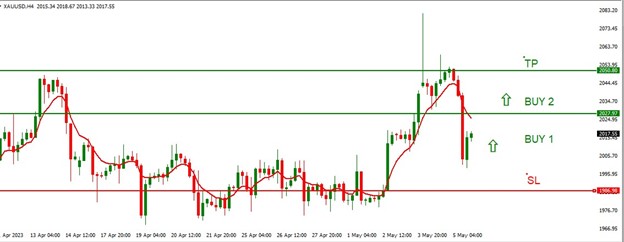EURUSD Report
The euro fell last week after some fluctuation occurred in a narrow range between ups and downs, as it opened the week at $1.1019, reached its highest level at $1.1090, and its lowest level at $1.0941, and closed the week at $1.1017.
The most important economic events that affected the euro last week
- Main Refinancing Rate
The main refinancing rate (MRR) is a key tool used by central banks to implement monetary policy and influence economic conditions within their countries or regions. Here are some of the main reasons why MRR is important:
- Regulating the cost of borrowing
- Inflation management
- Provide liquidity
- Influence on the exchange rate
In general, MRR is an important tool of the European Central Bank in managing the Eurozone economy, and has a significant impact on interest rates, inflation and other economic indicators.
By adjusting the MRR, the ECB can help steer the Eurozone toward its policy objectives, whether that be maintaining stable inflation, promoting economic growth, or ensuring financial stability.
Economic news that will affect the euro this week
- US Consumer Price Index (CPI) Monthly US Consumer Price Index (CPI)
- Unemployment Claims
- Core PPI m/m
- PPI m/m
EURUSD Technical analysis
The current technical data from the chart shown below indicates that the Euro may head higher against the US Dollar. Buying can start from the current closing price of 1.1017, with consolidation of buying from level 1.1038. The strong resistance line is targeted at 1.1091. A stop loss point is placed at the support line 1.0965.
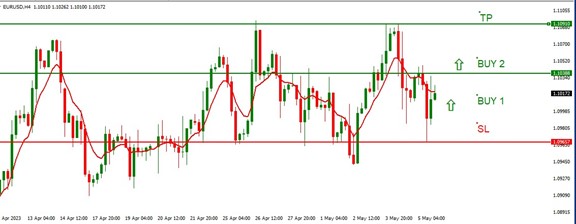
Opposite Scenario
According to the attached chart, the euro is expected to head downward, and therefore selling will take place when the closing price reaches 1.1017. In the event that the euro declines further, it will sell again from the level of 1.0989 and will target the area of 1.0934. The stop loss is placed at 1.1083.It is important to be cautious and make investment decisions carefully based on technical analysis, economic news and other relevant information.
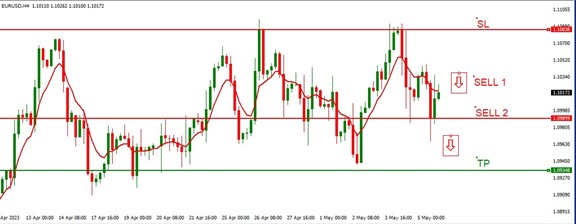
GBPUSD Report
The pound dollar rose last week after a fluctuation in its prices between ups and downs, as it opened last week at levels of $1.2586, reached its highest level at $1.2651, and its lowest level at $1.2434, and closed the week at $1.2633.
Past week from May 1 to May 5, 2023, the British Pound experienced an impact from several economic events, including:
- Bank of England meeting: The Bank of England held a monetary policy meeting on May 4, where it decided to keep interest rates at their current levels of 0.25%. A decision on the quantitative easing program was also announced, as it was decided to continue buying assets worth £895 billion until the end of this year.
- Economic data: Many important economic data were published during the past week, including industrial and manufacturing production data for the month of April, as productivity decreased by 0.7% compared to the previous month. Inflation data for April was also released, which slowed and rose 2.2% year-on-year, compared to 2.6% in the previous month.
- British politics: The past week witnessed developments in British politics, as a new £600 billion infrastructure development plan was launched over the period from 2023 to 2030, and an additional £20 billion in financing was secured to transform cities and develop clean energy.
This week is expected to be important for the British economy and the pound sterling, as a number of economic events and reports are expected to be announced that will affect the strength of the pound. Among these events:
- BoE meeting: The Bank of England’s Monetary Policy Committee meeting will be held on Thursday 11th May to discuss interest and inflation policies. Any change in interest policies is likely to lead to big moves in the GBP market.
- Economic reports: A number of important economic reports are scheduled for release in the UK over the coming week, including inflation and CPI data on Tuesday, May 10th, and retail sales data on Thursday, May 12th. These reports are expected to affect the strength of the pound and its ability to withstand other currencies.
- Trade talks between the United Kingdom and the European Union: Trade talks between the UK and the European Union are due to resume soon, and this is likely to weigh on the British Pound should there be any positive or negative developments.
GBPUSD Technical analysis
Based on the chart, it is clear that the pound dollar is showing an upward trend. Therefore, we can consider making a logical purchase, by buying the pair from the current closing area at 1.2633. Hence, buying can be strengthened from level 1.2694, and continue to rise, targeting level 1.2777. Note that the level of 1.2463 represents an appropriate and acceptable stop-loss area, as the deal is automatically exited if the price reaches this level.
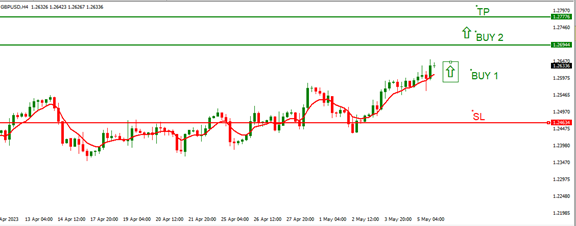
On the other hand, in the case of testing the opposite direction, we will sell from the closing area at the level of 1.2633 and the area of 1.2558, so we can target the level of 1.2434, and the stop loss level should be placed at the level of 1.2731.
It is important to be cautious and make investment decisions carefully based on technical analysis, economic news and other relevant information.
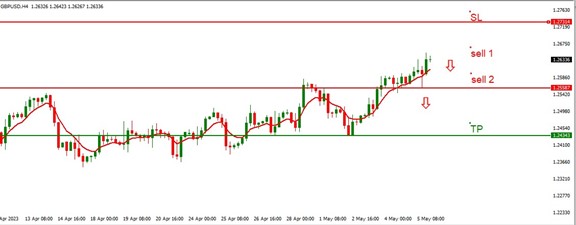
Gold Report
Gold rose last week, as it opened the week at the level of $1990 an ounce, and reached its highest level at $2081 an ounce, and its lowest level at $1976 an ounce, and closed the week at the level of $2017 an ounce.
Last week, the gold market witnessed slight price volatility as a result of some impactful economic news. Among this news:
- US jobs data: Last Friday, the US Department of Labor announced a surprising increase in the number of new jobs during the month of April, as it amounted to 266 thousand jobs, compared to the market expectations, which were expecting a decrease of 20 thousand jobs. This announcement negatively affected gold prices, as it signals an improvement in the US economy, and thus makes other assets more attractive to investors.
- European Interest Decision: On the same day, the European Central Bank decided to keep interest rates unchanged, but announced an increase in its bond-buying program. This announcement positively impacted gold prices, as it reflects the European Central Bank’s commitment to maintaining financial stability and stimulating the European economy.
- The recovery of the Chinese economy: Last week, the Chinese central bank announced an increase in the provision of credit to local banks, which indicates an improvement in the Chinese economy. This announcement negatively affected gold prices, as China is the largest consumer of gold in the world, and therefore any improvement in its economy increases demand for other assets.
Given the economic events scheduled to take place in this week, the following events could affect the performance of the gold price:
- US Federal Reserve Monetary Policy Meeting (Wednesday): The Federal Reserve is expected to keep the interest rate unchanged and continue to indicate an improvement in the US economy and inflation. However, any unexpected move may affect gold prices and market movements.
- US Nonfarm Payrolls (Friday): The US Nonfarm Payrolls report is expected to show an increase in the number of jobs added in April 2023 by 720,000 jobs. Any unexpected report can lead to volatility in gold prices and market movements.
- UK inflation data (Wednesday): UK inflation data is expected to show inflation in April 2023 rising by 3.3%. This may affect the British currency and gold prices.
- China Industrial Production Data (Sunday): China’s industrial production data is expected to show a rise in April 2023 of 5.5%. This may affect the global demand for gold and its prices.
GOLD Technical analysis
Based on the chart below for the underlying assets, we notice that the prices are moving in a downward direction.We can see the potential for a downward reversal from the current point. Therefore, we will sell from the closing point at the price of 2017 and consolidate the sale from the point of 2003.
Likewise, we target 1978 as a profit-taking area, where strong support is expected. We will place the stop loss at 2037 to reduce the risk.
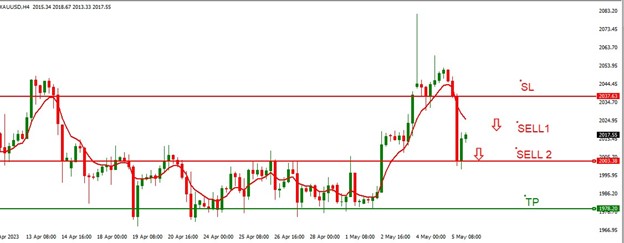
Gold is trading in a specific price range between the 2017 support level and the 2027 resistance level.
In the event that the price of gold rises and breaches the resistance level at 2050, it is possible for the bullish trend to continue until the level of 1986 as a stop-loss area.
